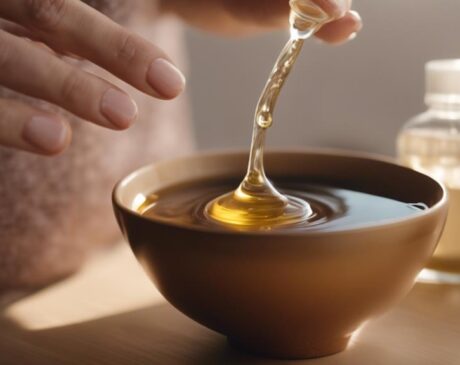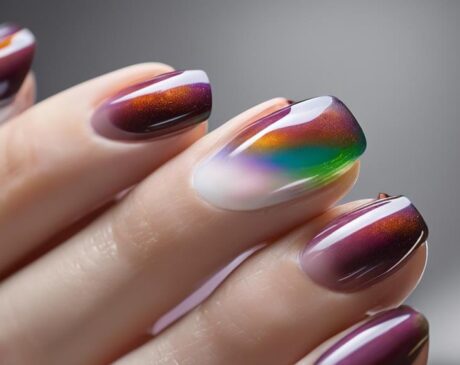How Long Does It Take for Nail Polish to 100% Dry?
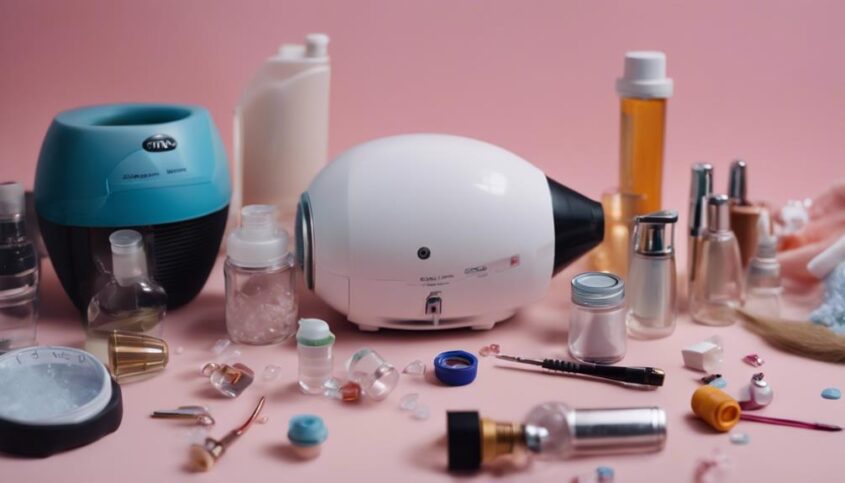
Nail polish can take varying times to dry completely, influenced by the product's formula, application method, and surroundings. Quick-dry formulas with evaporative components may set faster, especially in warm, low-humidity environments. Thin, uniform coats of polish typically dry more rapidly than thick layers. Some brands offer polishes drying in under a minute, while UV or LED light-cured options provide instant results. Techniques such as using quick-dry drops, applying thin coats, and a fast-drying top coat can speed up the process. Testing dryness through touch, smudge, sound, ice water, or cotton ball methods confirms readiness. Understanding these factors aids in achieving 100% dry nails.
Key Takeaways
- Perform a touch test to assess dryness accurately.
- Smudge test reveals any remaining tackiness.
- A hard clicking sound indicates fully dry polish.
- Ice water test distinguishes dry from wet polish.
- Cotton ball test checks for wetness or stickiness.
Factors Affecting Drying Time
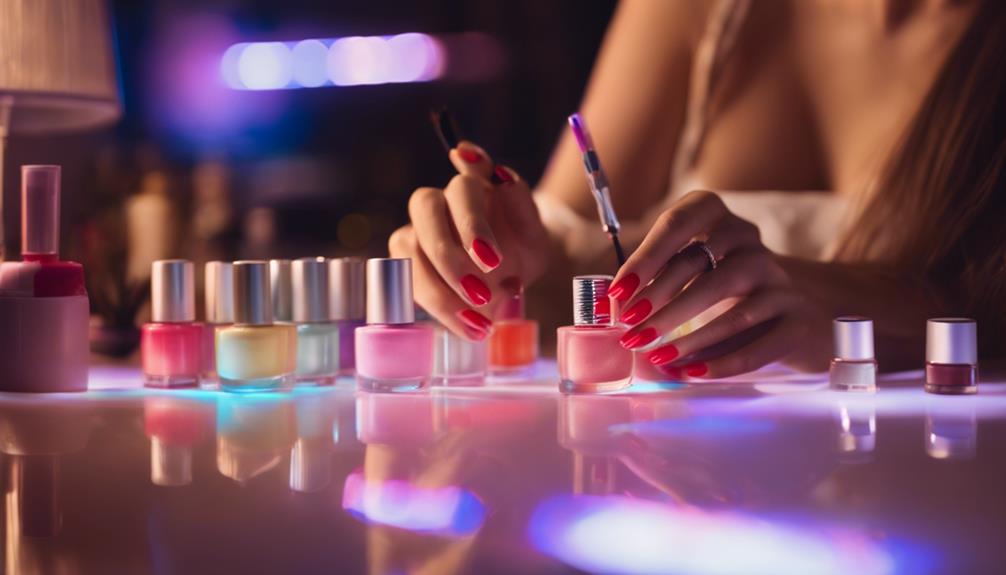
Factors that influence the drying time of nail polish include the formulation of the product, environmental conditions, and application technique. The formulation of nail polish plays a crucial role in determining how quickly it dries. Innovations in nail polish formulations have led to the development of quick-dry formulas that contain ingredients designed to evaporate rapidly, reducing drying time significantly. Environmental conditions such as temperature and humidity also impact drying time. Warmer temperatures and lower humidity levels generally help nail polish dry faster, while cold and humid conditions can prolong the drying process. Additionally, the technique used to apply nail polish can affect drying time. Thin, even coats dry faster than thick, gloopy layers. Innovations in application tools, such as wide brushes that cover the nail in a single swipe, have emerged to streamline the application process and reduce drying time. By understanding these factors and utilizing innovative products and techniques, consumers can achieve faster drying times for their nail polish.
Quick-Dry Nail Polish Options
Several innovative quick-dry nail polish options have emerged in the beauty industry, offering consumers efficient solutions for faster drying times. These cutting-edge formulations contain ingredients that help accelerate the evaporation of solvents, reducing the overall drying time significantly. Brands have introduced quick-dry nail polishes that claim to dry in as little as 60 seconds, catering to individuals with busy lifestyles who seek convenience without compromising on quality.
One popular quick-dry option is the aerosol spray nail polish, which provides a quick and even application, allowing the polish to dry rapidly. Another advancement in quick-dry technology is the use of UV or LED light-cured nail polishes. These polishes harden and dry instantly when exposed to the respective light source, offering a smudge-free finish in a fraction of the time traditional polish would take to dry.
For those looking to achieve salon-quality results at home in record time, these quick-dry nail polish options are revolutionizing the nail care industry, providing a fast and efficient solution for busy individuals who want flawless nails without the wait.
Tips for Speeding Up Drying Process
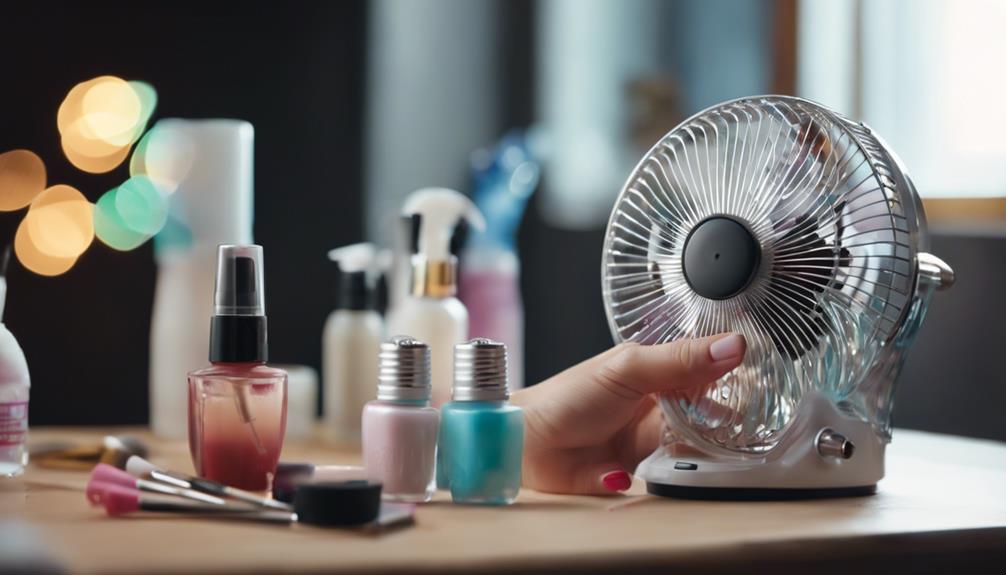
Efficient techniques can be employed to expedite the drying process of nail polish, ensuring quick and flawless results. To speed up the drying process, consider the following innovative tips:
- Quick-Dry Drops: These specialized drops are designed to rapidly dry nail polish, saving you time and preventing smudges.
- Cold Water Bath: After allowing your nails to air dry for a few minutes, submerge them in a bowl of cold water for a quick set.
- Thin Coats: Applying thin layers of nail polish ensures quicker drying times compared to thick, gloopy coats.
- Top Coat: Finish off your manicure with a fast-drying top coat to seal in the color and add an extra layer of protection.
Common Mistakes That Slow Drying
One significant hindrance to the timely drying of nail polish is the application of overly thick layers, impeding the evaporation of solvents and extending the drying duration. When thick layers are applied, the outer part dries first, forming a barrier that traps the solvents within the lower layers, leading to prolonged drying times. Another common mistake is failing to allow sufficient time between coats. Applying the next layer before the previous one has dried properly can result in smudges, dents, or an overall longer drying process. Additionally, exposure to water or heat immediately after painting can slow down the drying process. Water can cause the polish to soften and become more susceptible to damage, while heat can interfere with the solvent evaporation. Lastly, not using a base coat or top coat can also extend drying times, as these layers help seal in the color and protect the polish, ensuring a quicker and more durable drying process.
How to Test for 100% Dryness
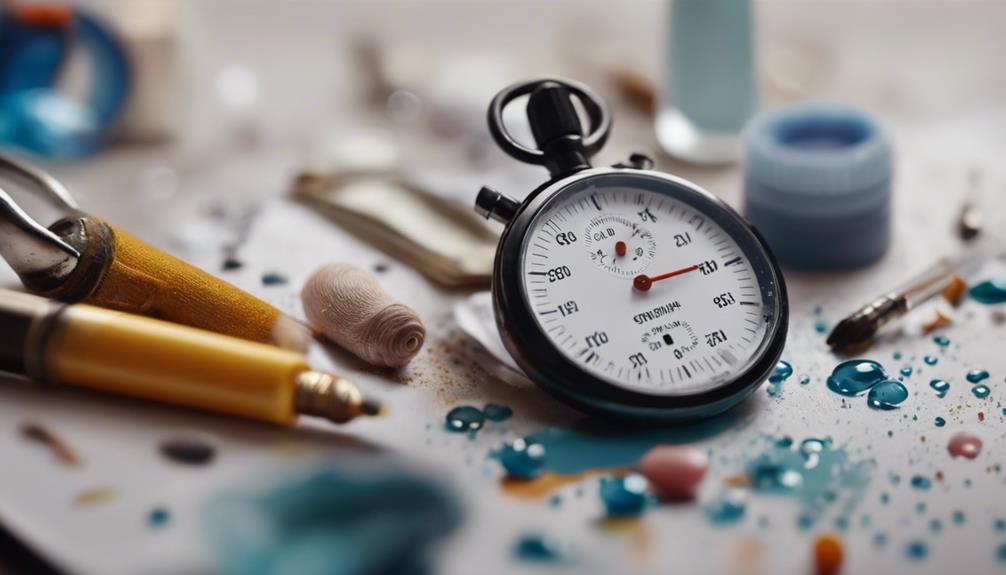
To determine if your nail polish has dried completely, perform a simple touch test on an inconspicuous nail surface. Lightly tap your nail against another nail or surface to gauge the dryness. If the polish feels tacky, sticky, or leaves a mark, it is not fully dry yet. Here are four innovative methods to test for 100% dryness:
- The Smudge Test: Gently press your thumb against the painted nail. If the polish smudges or leaves a dent, it's not dry.
- The Sound Test: Tap your nail with a fingernail from your other hand. A fully dry nail polish will produce a hard, clicking sound.
- The Ice Water Test: Dip your nails into a bowl of ice-cold water for a few seconds. Dry polish will remain intact, while wet polish will show smudges.
- The Cotton Ball Test: Rub a cotton ball gently over the painted nail. If any cotton fibers stick to the polish, it's not fully dry.
Frequently Asked Questions
Can Using a Hairdryer Speed up the Drying Process of Nail Polish?
While using a hairdryer may seem like a convenient way to speed up nail polish drying, it can actually lead to uneven drying, bubbles, or even melting. Opt for quick-dry topcoats or natural air-drying methods for best results.
Does the Color of the Nail Polish Affect How Long It Takes to Dry?
The color of nail polish can influence drying time due to pigment density affecting evaporation rates. Darker shades often take longer to dry due to higher pigment concentration. Quick-dry formulas may help mitigate this issue for faster results.
Can Applying Multiple Thin Coats of Nail Polish Make It Dry Faster Than One Thick Coat?
Employing multiple thin coats of nail polish can accelerate drying time. This method enhances evaporation rates between layers, promoting quicker overall drying. Opting for thin applications instead of a single thick coat can indeed expedite the drying process.
Will Using a Top Coat or Base Coat Affect the Drying Time of Nail Polish?
Using a top coat or base coat can affect the drying time of nail polish. These specialized products are formulated to enhance the durability and shine of nail polish. They may also help speed up the drying process for a more efficient manicure experience.
Is There a Difference in Drying Time Between Regular Nail Polish and Gel Nail Polish?
Regular nail polish typically dries through oxidation, taking longer to set completely. In contrast, gel nail polish dries quickly under UV light, offering a more efficient and durable finish. The difference in drying time stems from the curing process.


